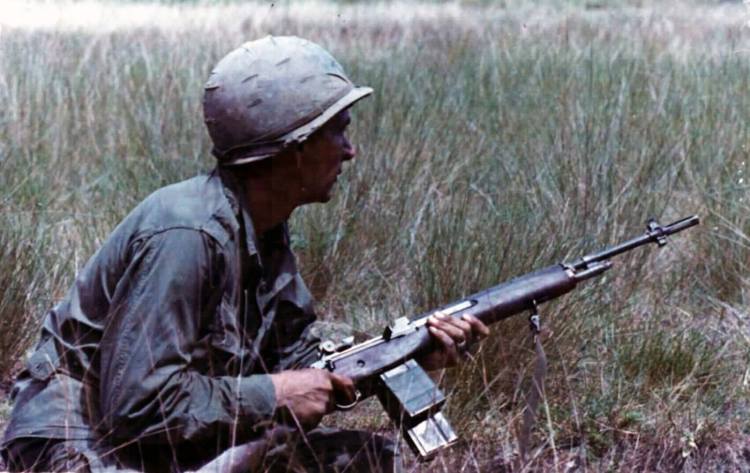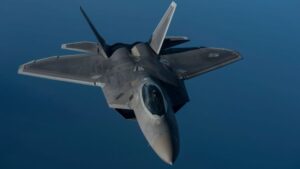One pervasive myth that’s continually floated around is the legend of the M14. I hear it all the time and have heard it since I was a young buck with dreams of joining the USMC. I thought the M14 was a legendary rifle, and troops in Iraq and Afghanistan would benefit from it. Of course, this wasn’t based on experience but on me repeating what the gun rags said. However, the truth is completely different, and the truth is that the M14 was a terrible rifle.
Why Does It Seem Beloved?
So, why has the M14 seemingly been getting so much love? Well, the most obvious answer is the M16: more specifically, the M16’s terrible rollout. The Army goofed it up big time. Specifically, the XM16E got a bad rap because Big Army knowingly used the wrong powder in their ammunition, and the chamber and bore were not chrome plated.
Big Army goofed hard, but not every grunt in Vietnam hated the M16. That seems to be the prevailing narrative, but a survey from the U.S. Army shows differently.
Infantry Marines, who had been in Vietnam for more than six months, were surveyed for a report titled Small Arms Use in Vietnam: M14 Rifle and 45 Caliber Pistol. These men were all below the rank of captain and, if possible, were squad leaders. Sixty-seven percent carried the M14 at the time of the survey.
Here are a few choice quotes when they were asked their thoughts on equipment:
Grunt Thoughts
“What do you need (type of,’ capon, ammunition, or anything else) which would help you the most?”
“Fiberglass or another form of stock for the M14, which can withstand the beating an infantry man deals out.”
“A lighter and shorter weapon.”
“A lighter automatic rifle with lightweight magazines made of an alloy which would be more resistant to rust.”
“A more durable rifle… The flash suppressor is too easily broken or knocked out of line. Thus causing poor shooting as well as endangering the Marine firing the rifle.”
“A lighter, faster firing rifle than the M14.”
“My choice would be AR-15 or STONER (M16). Reason [sic] because most combat encounters in the infantry is close range; need firepower not well aiming. The M16 rifle would be more useful in the type of close combat in Viet Nam because of its high volume of fire. Also, because of its lighter weight, which enables a trooper to move much faster, and also he can carry more ammo than usual.”
“A lighter weapon, a magazine that holds more rounds for all personnel.”
“Newer ammunition. Wood on rifle stocks for M14 is swelling too much in rain. After taking the rifle apart It Is impossible to put it back together without drying the stock first.”
“Easier carrying rifle, non-corrosive, improvement on the present magazines.”
“A rifle that is accurate up to 300 yds. not so bulky (big) and less weight. The M16, to me, seems to fulfill the bill more sufficiently because of its weight and has also been proven effective in marksmanship as well as the M14.”
“AR-15s are outstanding for jungle fighting.”
“Need a weapon which would stand up under a very hard beating. The M14 is not strong enough for Jungle fighting, But in the open terrain, the M14 is a very good weapon.”
It Goes on and On
“Get the M16.”
“A lighter more accurate rifle and be able to carry more ammunition for it.”
“A light weapon, more firepower, more rugged, easier to clean, less parts. I think that the M -16 is a very good weapon and every marine should have one.”
“A weapon which is light. Also can take punishment. And this weapon should be automatic and semi.”
“A lighter weapon that would be more compact and would take up less space when moving through brush or when handling POW‘s. An easier-to-clean and keep effective weapon.”
“The M-14 does not function properly in rainy weather. Mud seems to clog action. The weapon also seems to rust heavily and slow down the rate of fire.”
The above are just a few selective comments I gleaned. There are many more advocating against the M14 or advocating for the M16, or just desiring a lighter, shorter weapon that allows them to carry more ammunition.
Advocates for the M14
To be fair, I also found comments advocating for the M14. Nevertheless, these four comments are the only ones seemingly advocating for the M14 or speaking against the M16.
“We need an M-14 rather than AR-16.”
“The M14 is about the best weapon that an infantryman can use.”
“Everything that I have here meets my needs. No other weapon can compete with the M14.”
“Let the Army keep the M-16s.”
You can read the complete survey here.
The M14 and its Many Issues
The biggest issue was that the M14 was an M1 Garand with a removable magazine. It was outdated before it was built. In fact, I’d argue, the design was outdated even when Nazi Germany fielded the STG 44.
The M1 Garand was state of the art in 1939, but by 1959 the world and warfare had changed. The long-stroke gas system degrades accuracy and causes excessive recoil. It works okay in rifles like the AK 47 but falls apart in full-sized, full-powered rifles. Short stroke gas systems are much more effective if taking the piston route.
Additionally, the open action allowed dirt and debris to enter the gun. In 1939 the M1 Garand had been great, but even by 1947, the Soviets figured out that an open action was a bad idea.
Carol Schuster of Vietnam magazine wrote this regarding the M14.
“The primary complaints were fragile receivers, malformed bolts, poor accuracy, and instability during automatic fire. All of those problems but the last were fixed by better quality control, and the stability issue was addressed by limiting 90 percent of the rifles to semi-automatic mode.”
Like the M16, the M14 rollout was fraught with issues.
No One Made Them Well
Promises that the M14 could be produced on M1 tooling quickly fell apart and its cost skyrocketed. It was difficult to produce the rifle. LooseRounds dug up a report titled Report on Tests for Ad Hoc Committee on Accuracy and Testing of 7.62mm Ammunition and M14 Rifles.
The report took batches of rifles from H&R, Winchester, and Springfield Armory and found that:
“All of the rifles from Winchester and H&R exhibited excessive headspace.
All of the rifles had loose handguards.
Ninety-five percent of the rifles had loose stock bands.
Ninety percent of the rifles had loose gas cylinders.
Seventy-five percent of the rifles had misaligned op rods and gas pistons.
Fifty percent of the rifles had loose op rod guides.
Fifty percent of the rifles had op rods that rubbed the stock.
Three rifles had barrels that exceed the maximum bore dimensions.
Only three rifles had an average bore diameter that fell below the accepted mean diameter.
One rifle was found to have a broken safety, while another had a misassembled safety spring.
One rifle had a misassembled flash suppressor, which was actually contacting bullets during live-fire tests.”
Check out this link for more info.
The M14 Had Poor Ergonomics
A reciprocating charging handle was the norm at the time, but it was excessively bad here. Instead of just the handle and bolt coming rearward, a portion forward of action also moved. This made it tough to move your hand rearward to accommodate weird shooting positions.
Weight was also an issue. This was a 10-pound rifle without optics, rails, lights, etc. The M14 was also 44.3 inches long. That’s great for the open field of Europe in World War II. Yet it was poorly suited for the jungle warfare of Vietnam.
Springfield Armory disliked modern ergonomics and used a traditional straight stock. This did not aid the user’s ability to control the rifle. Speaking of, a fully automatic 7.62 NATO rifle in full auto was a nightmare to control.
The M14 Was Not Accurate
Accuracy and the M14 is a fun subject. It’s one of the many legends regarding the gun. The legend was fueled by the fact that the Army used the M21 as a sniper rifle, and the M14 served as a DMR in the Global War on Terror.
Your average good M14 was around three to four MOA, which for an assault rifle isn’t terrible. However, it’s not as accurate as a DMR or sniper rifle. An M14 can be accurized, but it’s a finicky process and results in a fragile state. This is because the M14 is fully set into the stock and does not have a free-floating barrel.
The rifle could be rendered unaccurized by field stripping, bumps, and tumbles. Even applying too much pressure to the handguard could cause accuracy issues. In Vietnam, the moisture could cause the stock to swell, and a swollen stock shifts zero considerably.
Green Beret and Weapon Sergeant Kevin O’Brien from the Weaponsman blog said, “The operator was not permitted to field-strip the gun — that was strictly for the armorers who built the thing.”
He described the M21, the sniper variant of the M14 as, “a fiddly, unstable platform.”
The Global War on Terror
So, if the rifle was so terrible, why did we use it in the Global War on Terror? Well, quite simply, they didn’t have many other options for a 7.62 semi-auto rifle early on in the war. It was a niche use, and the M14 was pressed into service once more as a DMR rifle.
In its original configuration, the M14 is not accurate and was designed to work with an optic. The stock of the M14 is designed for use with iron sights, so the taller optics required a fix to the cheek weld. Oftentimes soldiers and Marines duct-taped soft padding to the stock to get a cheek weld to work with the optic.
The Army placed the rifle in a chassis system. Specifically, the Sage EBR chassis system was the most common. It allowed for optics use, a collapsing stock, and greater accuracy than the wood stocks. However, even in these stocks, the rifles could be finicky.
Ash Hess, a former career soldier who helped modernize the Army’s shooting program, described the EBR M14s in a Primary and Secondary Podcast. He found out that taking the rifle apart rendered all the accuracy work moot. A supposed 1 MOA gun became a 3 MOA gun. When the torque on the trunnions changed, the accuracy disappeared.
In-country, the rifle’s exposed action became a major issue. It turns out sand will disable a rifle. Soldiers couldn’t take the rifle apart to clean it properly without risking the zero they held in their optic.
Beat by the M16 Once More
By 2008 most designated marksmen carried Mk12 rifles. The Mk12 used an M16A1 receiver with an accurized upper, Leupold scope, and 18-inch barrel. Ironically, the M16 once more replaced the M14 DMR rifles.
To kill the old M21, Knight’s introduced the M110. This AR10 style rifle is more accurate, lighter, easier to attach an optic to, more ergonomic, more reliable, and just a better rifle all around. Both the U.S. Army and Marine Corps adopted the M110 as their modern sniper rifle.
US Army Special Forces/Green Berets, Vietnam War, FOB Kham Duc, February 1967. They are armed with a mix of M79 40MM grenade launchers and early 5.56 M16s. From left to right: SSG Parsons, SSG Brakeman, SFC Simpson, SFC Strick, SSG Sheppard, 1LT Sullivan.
The M14’s legacy is a weird one. But it is not a good one. After six years of general infantry service, the rifle went the way of the Krag-Jorgensen for a reason. While many people still love modern M1As, it’s important to remember that an M1A is not an M14. They’ve had decades to improve the design. The M14 exists as a middle child of infantry rifles. It never had and never will have the success or glory of the M1 Garand or the M16.
—
Disclaimer: SOFREP utilizes AI for image generation and article research. Occasionally, it’s like handing a chimpanzee the keys to your liquor cabinet. It’s not always perfect and if a mistake is made, we own up to it full stop. In a world where information comes at us in tidal waves, it is an important tool that helps us sift through the brass for live rounds.



